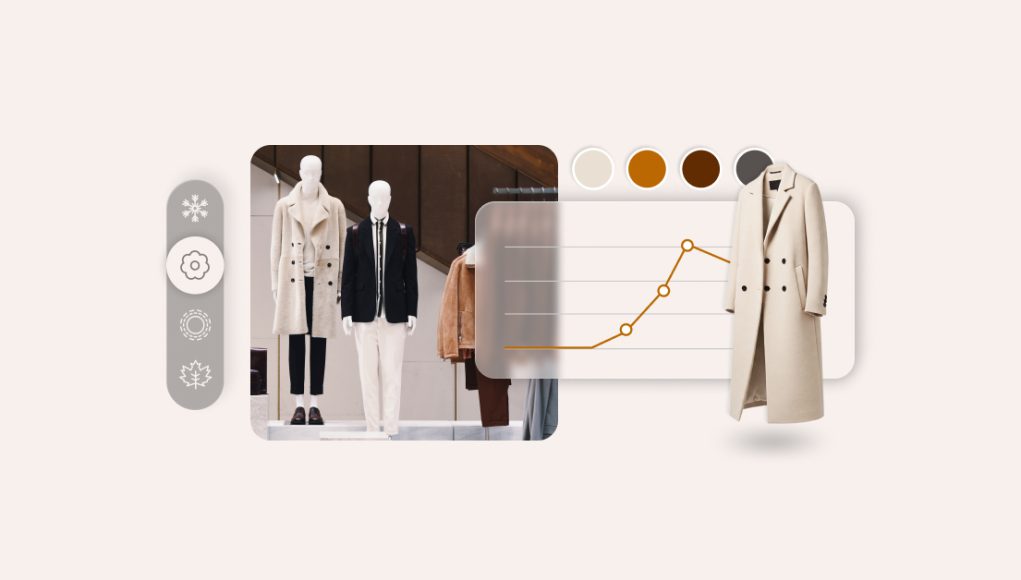Seasonal changes aren’t just marked by shifts in weather—they’re reflected in the world around us. The first buds on a tree, a flake of snow or the arrival of the rainy season all signal a transition. But beyond mother nature, we can also see the seasons change through the displays in our favorite stores.
When you walk into a boutique and notice colors shifting from cool to warm or bathing suits being moved to the back, that’s fashion assortment planning in action.
What is fashion assortment planning?
Fashion assortment planning is the process fashion retailers use to decide which products to sell and display in specific periods of the year. And it goes beyond just the weather—it considers styles, trends, sizes, colors and locations.
A well-developed fashion assortment plan can give retailers a competitive advantage—improving customer satisfaction, optimizing inventory management and increasing profitability. It keeps things fresh, engaging and on-trend for the brand. Of course, fashion assortment planning comes with its challenges. The fashion industry is constantly changing and evolving, making it difficult to stick to a rigid plan. That’s why it’s crucial to balance risk and reward to stay ahead.
In this guide, you’ll learn how to strengthen your fashion assortment plan with these key tips:
Master assortment planning
Streamline your supply chain, optimize your inventory and leverage real-time reporting tools to elevate your fashion assortment plan.
Fashion assortment planning tips and best practices
1. Start with a merchandising plan
This plan is essentially your product budget for the year—a high-level strategy outlining how you’ll distribute finances to ensure products roll out at the most opportune time. It includes key elements like pricing strategies, visual merchandising (both in-store and online), sales forecasting, inventory management and assortment planning.
2. Break it down into specifics
A fashion assortment plan builds on the merchandising plan by concentrating on the particular products and categories. It’s normally updated every couple of months to adapt to new styles and seasons.
For example, if your merchandising plan includes a dedicated winter section, your fashion assortment plan will determine which items to feature—such as trending winter jackets, sportswear and seasonal fashion must-haves. However, like many aspects of the fashion industry, you have to be ready for change because it’s not an exact science.
3. Timing is everything
Successful fashion assortment planning requires careful scheduling, especially for multi-store retailers balancing a consistent brand presence across various locations and platforms.
Aritzia, a North American staple, is a great example of a brand that continuously evolves its fashion assortment plan. It’s rare for their stores to look the same from month to month—they’re always updating their displays, introducing fresh styles and keeping things interesting for shoppers. As a global brand, their approach varies by location, ensuring their assortment aligns with regional preferences and market demands. This constant evolution helps them stay relevant, no matter where they are.
4. Plan—but stay flexible
A well-structured plan is crucial, but adaptability is just as important. Staying on top of fashion trends while maintaining brand identity and keeping loyal customers engaged is a delicate balance. Some trends are fleeting, so it’s essential to react thoughtfully—trying not to overcommit or miss an opportunity. The perfect assortment plan doesn’t exist, so continuous refinement is key.
5. Use data to drive assortment decisions
At the core of fashion assortment planning is the customer. To keep existing customers happy, attract new ones and maintain brand loyalty, retailers need to offer products that meet the current demand. Understanding your customers’ needs and preferences is essential.
Beyond knowing who your customers are, it’s crucial to grasp how trends influence their buying decisions. For this, retailers must stay on top of key data points.
Some of the key data points for fashion assortment planning include:
- sales history
- data analysis
- customer insights
- market trends
By understanding your sales history, you can identify top-performing products and pinpoint those that aren’t selling. With data analysis, customer insights and understanding key market trends, you can get to know the important patterns in the industry and understand the demographics and behaviors of your community and beyond.
This allows you to make informed decisions about what to stock and promote. Using historical data and past inventory trends, you can also plan ahead beyond seasonal replenishment.
Lightspeed Insights is a powerful tool designed to help you optimize your fashion assortment plan by providing comprehensive analytics and reporting capabilities in real time.
Lightspeed Insights also offers customizable reporting options, enabling retailers to focus on specific categories, sales periods or customer demographics. This flexibility makes it easier to tailor your assortment planning to meet customer demand and maximize sales.
6. Streamline the supply chain: improve efficiency with technology
When assortment planning, it’s essential to use intuitive technology that ensures you can easily place orders with your wholesalers and brands. This not only saves time and reduces headaches but also provides greater visibility across your entire inventory.
As a retailer, you’ll have more time to focus on your customers and your creativity—ordering products you know they’ll love and enhancing your brand by having the time to build out your style and presence without the burden of a time-consuming ordering process.
Lightspeed NuORDER is a B2B ecommerce platform that connects brands and suppliers with retailers, creating a seamless wholesale buying and selling experience. Key features, such as digital catalogs, order management and real-time analytics, help foster strong partnerships between businesses.
Take Diane from The White Orchid, for example. Thanks to NuORDER, she saves about 90 minutes per order, giving her more time to focus on less redundant tasks. With the digital catalog, she no longer needs to attend trade shows, and everything is seamlessly integrated with Lightspeed’s POS system.
Having one streamlined platform to view your brands, discover new suppliers and interact ensures you’re always ready for changes to your fashion assortment plan.
7. Optimize inventory: implement smart inventory management strategies to balance supply and demand
A well-executed inventory strategy ensures retailers can meet demand without overstocking or running out of key items.
Lightspeed’s inventory management system is designed to support seamless fashion assortment planning. Real-time inventory tracking provides a clear, in-depth view of product performance and stock levels, allowing you to make immediate adjustments based on trends and customer behavior.
To streamline operations further, automated reorder points help prevent stockouts and reduce time-consuming manual processes. Low-stock alerts make it easier to stay ahead of inventory demands and refine assortment planning.
For multi-store retailers, Lightspeed offers complete inventory visibility across all locations, ecommerce platforms, marketplaces and social media channels. Additionally, Lightspeed’s Insights and inventory management system can facilitate demand forecasting by analyzing past sales data and identifying patterns over the last two years, helping retailers anticipate demand more accurately.

Bringing it all together
Success in fashion retail requires balancing a structured assortment plan with a flexible, adaptive mindset. Understanding its fundamental role, knowing when to plan versus when to act, leveraging key data points, optimizing inventory and streamlining your supply chain will help keep your brand fresh and engaging. Watch a demo to see how Lightspeed can help you get there.
FAQs about fashion assortment planning
1. What is fashion assortment planning?
Fashion assortment planning is the process retailers use to decide which products to sell and display at any given time considering styles, trends, sizes, colors and locations.
2. How does data help with fashion assortment planning?
Data-driven decisions help retailers predict demand, identify trends and optimize inventory levels. Tools like Lightspeed Insights analyze past sales, customer behavior and market trends, giving retailers the insights they need to curate a product mix that maximizes sales and minimizes stock issues.
3. How can retailers adapt their assortment plan to trends?
A strong fashion assortment plan provides a framework, but flexibility is key to adapting to fast-changing trends. Retailers can stay agile by leveraging real-time inventory tracking, demand forecasting and supply chain solutions like Lightspeed NuORDER to make informed adjustments as customer preferences evolve.








